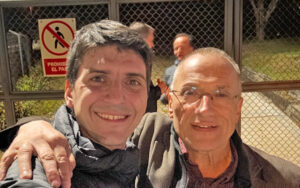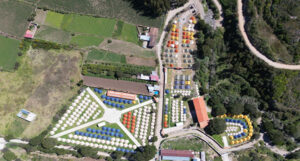
Source research
Fairy tales may pass on worldly wisdoms to children and grown-ups, but they lack even a hint of historical accuracy. That is why this genre of stories cannot be identified chronologically. That is why they normally start with “Once upon a time…” and end with the words “… and they all lived happily ever after”.
Legends on the other hand do have historical references. For example, they describe the deeds of people who played a role in history. Their character traits are glorified and enhanced. One example are the heroic epics that talk about El Cid’s deeds during the Spanish Liberation Struggles.
History writers on the other hand try to get to the hard facts. Many scientific instruments are used in order to penetrate to the true happenings of events that happened centuries ago. Archeology plays a large role when finding out about historical events. In no region of the world have archeologists worked so thoroughly as in the Holy Land. Can finds in the desert sand, the surviving historical documents and the available circumstantial evidence help us to draw closer to the story of Christmas?
40 years ago when I attended a secondary school in Wiesbaden the theologian Rudolf Karl Bultmann was still alive. He believed that our knowledge of the historical Jesus was extremely limited. One would have to demythologise the Biblical texts in order to, in the deepest layer of one’s enquiries, perhaps hopefully find some historical fragments. Back then at school we learnt that the contents of the New Testament were handed down orally from generation to generation and were written down 150-250 years after Jesus’ birth. The quintessence was: interesting texts, but please do not take them literally.
But science has developed further. A thorough analysis of many papyri has made it necessary to pre-date several New Testament texts. In the meantime we have arrived at the generation of the first hour, i.e. the eye-witnesses. That is why the Gospels deserve our special attention. Normally Luke’s version of the Christmas Story is read. But who was Luke? He did not belong to the guild of the Grimm Brothers, but was a doctor, an intellectual, a contemporary of the Apostles and a protagonist in the early Christian Church. He wrote the gospel that bears his name in the 60s of the 1st Century and was able to draw from several historical written documents. In the preface addressed to a certain Theophilus he writes: “Many have undertaken to draw up an account of the things that have been fulfilled among us, just as they were handed down to us by those who from the first were eyewitnesses and servants of the word. With this in mind, since I myself have carefully investigated everything from the beginning, I too decided to write an orderly account for you, most excellent Theophilus, so that you may know the certainty of the things you have been taught.” It is worth mentioning that for his research Luke had access to reliable eye-witnesses. The historian Luke who shines brightly through the interesting detailed comments in his writings, firmly sets his documentation of Jesus Christ in a temporal context. His declared objective is relating facts, not elaborating sentimental anecdotes. Part 2 of his chronology can be found in the book of Acts, many sections of which Luke writes as an eye-witness.
Even if not all scientists who evaluate Luke’s writings come to the same conclusion, they are nevertheless reports of highest historical quality. No one would doubt the value of Josephus as a historian, only because some historians doubt some of the figures he gives in his great work “The Jewish War”. Garcilaso de la Vega, who wrote down the story of the Incas in Spanish Exile, gives us one of the best extant sources for this period in history, even if some of his details are controversial.
In his documentation Luke addresses specifically an educated Hellenist and thereby appeals to the Hellenistic readership as a whole. The Hellenists were the leading intellectual current of his time. Philosophy, civics and psychology stood firmly on the foundation of great Greek thinkers. The companion of the Apostle Paul personally experienced how in the space of a lifetime the Christian faith spread from the eastern periphery of the Roman Empire to its capital. An incredible development that is closely connected with the name of Paul from Tarsus.
Paul was originally a Jewish intellectual of Gamaliel’s elite school. The fierce persecutor of the new teaching had an encounter with the risen Christ in front of the gates of Damascus in roughly 33AD. As a result he worked as the greatest evangelist of all times for the next 34 years. His missionary journeys can be dated to the 40s and 50s of the 1st Century. He knew the Apostles and countless eye-witnesses of Jesus’ miracles personally. He transported the good news of the Gospel through the Greco-Roman World so successfully that 50 years later the Governor of Bithynia, Pliny the Younger, in his correspondence with the Emperor Trajan often mentioned the topic “Christians”. We are now in the year 111A.D. The Christian faith has spread to such a degree throughout Asia Minor that the non-Christian Pliny is concerned about the Christian influence in all levels of society: religion, politics, economics…. These sources bear witness to the fact that faith in the Risen Christ gained more and more ground in Asia Minor and was soon a rival to the Greco-Roman gods. And that in the time frame of 2 generations.
The gospel-writer Matthew also presents us with a Christmas story. According to the oldest church tradition he was one of 12 Jesus’ disciples and was among the close-knit group of eye-witnesses. He probably wrote his gospel in the early 60s when both he, Paul and Peter lived in Rome. He wrote mainly for Jews and Jewish Christians, since he describes Jesus’ life as the fulfilment of Old Testament prophesies. In his writings he does not avoid Jesus’ conflict with the Jewish intellectual elite; both then and now their intellectual versatileness looks for an adequate equal.
The deciding question is: “Is Jesus Christ the Messiah, who the prophets announced would be the Saviour of the World?” The Roman historian Suetonius mentions how the religious argument between Jews and Christ created a huge stir in Rome. In order to put paid to this quarreling, which had even caused social unrest, the Emperor Claudius banned all Jews from Rome in 49A.D. In all the discussions the Jews had not been able to weaken the persuasiveness of Christian apologetics.
It is fascinating to discover that among the Old Testament texts that, according to Christian tradition, point to Jesus, the words of the prophet Isaiah count. For 2,700 years his words, especially the 53rd chapter of his book, contain convincing evidence for the passion of Christ. Not few rabbis tried to flee from this by saying that the 53rd chapter was not found the most ancient of manuscripts. But the Qumran scrolls prove that they were wrong. These Essene papers are two thousand years old, were discovered in the 1940s and can be looked at in the Shrine of the Book in Jerusalem. They include chapter 53, i.e. the passion of God’s Servant.
He who does not want to believe in God, nor that the person Jesus Christ is God’s revelation to us humans, also won’t be convinced by these historical facts. But (s)he who believes that Jesus Christ is the answer to mankind’s deepest questions will be encouraged by the archeological finds and the papyrus-findings of the past two generations.
The birth of Jesus took place, his crucifixion can be proved and his resurrection was confirmed by a multitude of witnesses. He preached and healed publicly for a mere three years, but right up to this very day millions of people have experienced him in prayer or in their everyday lives. Recently an ambassador of a Western European Country said to me: “I can see God constantly working in my life!” /KDJ a doctor like Luke.











